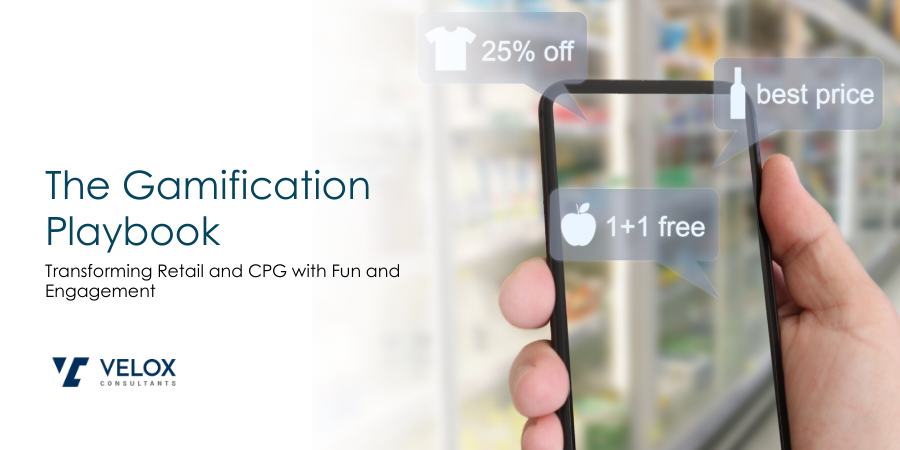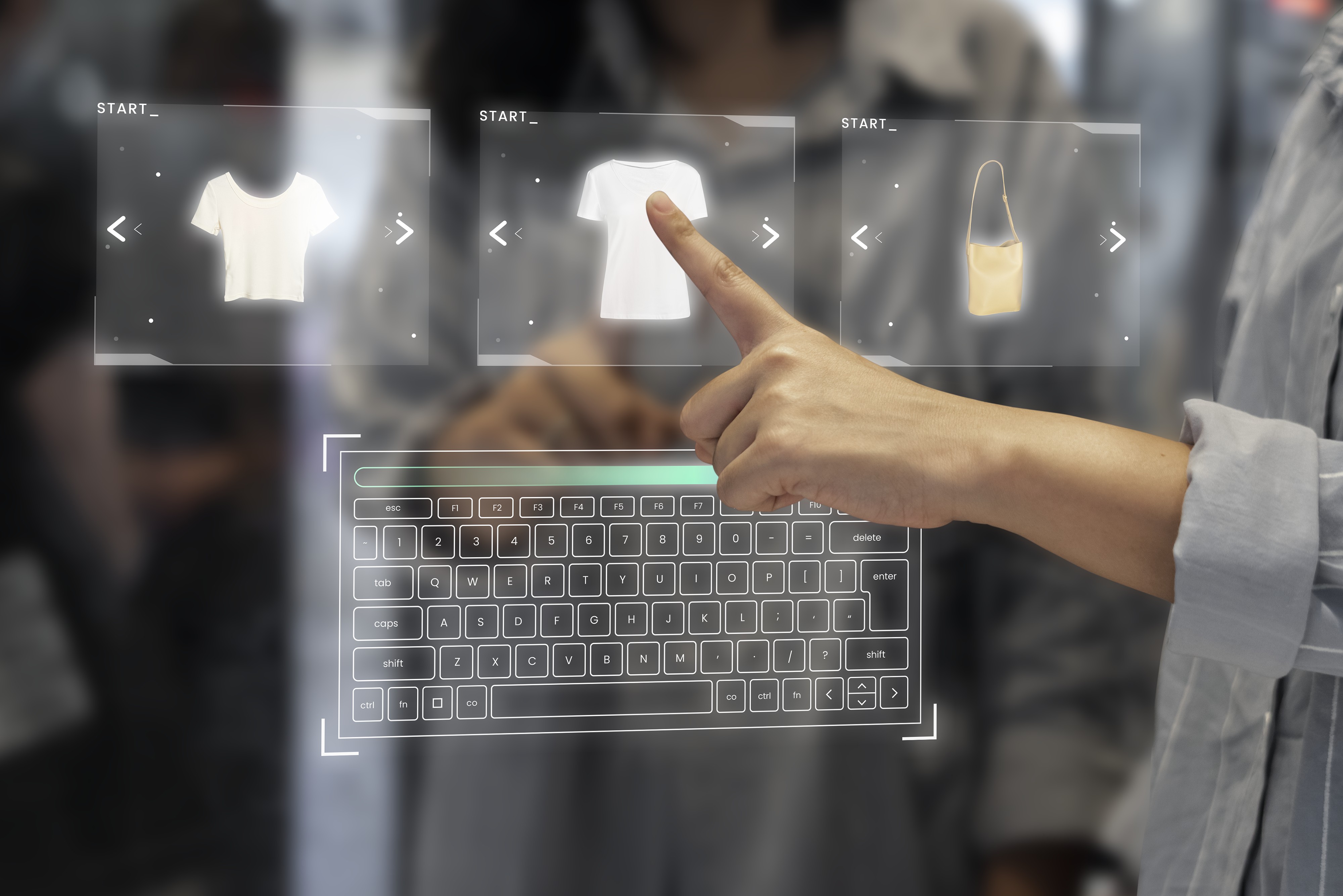An Overview
Gamification in the Retail and CPG industry leverages game design elements in non-game contexts to enhance customer engagement, loyalty, and conversion rates. By incorporating rewards, challenges, and interactive features into shopping experiences, companies can create compelling, immersive experiences that drive sales and customer retention. It can include challenges, competitions, virtual rewards, and progress tracking.
By incorporating gamified features like loyalty programs, badges, and points systems, brands can incentivise repeat purchases and foster consumer loyalty. Gamification techniques like quizzes, interactive product catalogues, and augmented reality (AR) experiences can facilitate product discovery and educate consumers about the features and benefits of various products.
Gamification allows brands to gather valuable consumer data, including preferences, shopping habits, and feedback, which can inform marketing strategies and product development. Many gamified retail experiences include social components such as leaderboards, challenges shared on social media, and user-generated content, which can amplify brand awareness and reach.
The global gamification market is expected to be worth more than US$60 billion by 2030, with an estimated CAGR of more than 25% from 2024 to 2030.
The global market for gamification in retail is projected to grow significantly, driven by the increasing demand for enhanced customer engagement strategies and the proliferation of smartphones and mobile apps. Key drivers include:
- Digital Transformation: The digital transformation in retail and CPG sectors is a significant driver of gamification. As businesses adopt digital technologies, they have more opportunities to integrate game mechanics into their customer interactions.
- Increasing Mobile Usage: The widespread use of smartphones has made mobile apps a primary touchpoint for engaging with customers. Gamification strategies tailored for mobile environments can significantly enhance customer interaction and retention.
- Consumer Expectations: Today's consumers expect personalised, engaging, and entertaining shopping experiences. Gamification meets these expectations by making shopping fun and rewarding, thus differentiating brands in a competitive market.
- Data-Driven Insights: Gamification enables brands to collect valuable customer preferences and behaviour data, which can inform product development, marketing strategies, and customer experience initiatives.
- Social Influence: The influence of social media and peer recommendations on consumer behaviour has made gamification an effective tool for brands to harness social sharing and word-of-mouth marketing.
Current Challenges in the Market
Implementing gamification in the retail and CPG sectors presents unique challenges. While the benefits are significant, ranging from enhanced customer engagement to deeper insights into consumer behaviour, companies face several hurdles in effectively deploying gamification strategies.
According to our survey, more than half of the respondents believe "Technology Integration" is the biggest challenge while implementing gamification in the retail and CPG industry, followed by "Long-term Gamified Experience".
- Balancing Fun and Functionality: Creating a gamified experience that is both fun and relevant to the brand or product can be complex. Ensuring the gamification elements enhance rather than complicate the shopping experience is crucial.
- Maintaining Engagement Over Time: Keeping users continuously engaged with gamification elements is challenging. What initially excites and motivates users can quickly become monotonous, leading to disengagement.
- Integrating with Existing Systems: Seamlessly integrating gamification elements into existing retail and CPG platforms (e.g., e-commerce sites, mobile apps) can be technically challenging, requiring significant backend work and possibly disrupting current processes.
- Ensuring ROI and Effectiveness: Quantifying gamification's impact on key performance indicators like sales, customer retention, and brand loyalty can be difficult. Establishing clear metrics for success is essential. Tangible benefits must justify the costs associated with developing and maintaining gamified experiences.
- Regulatory and Ethical Concerns: Gamification often involves collecting personal data. Adhering to privacy regulations (such as GDPR in Europe) and ensuring data security is paramount. There's a fine line between encouraging engagement and manipulating behaviour.
- Cultural and Demographic Sensitivity: It is challenging to design gamification elements that appeal to a broad audience, considering cultural differences and varying demographic preferences. Ensuring gamified experiences are accessible to all users, including those with disabilities, is crucial but can be difficult to achieve.
Emerging Business Trends and Impact of Emerging Technologies
The gamification market within retail and CPG sectors is rapidly evolving, driven by emerging business trends and new technologies. These changes shape how companies engage with customers, offering innovative ways to enhance the shopping experience, deepen customer loyalty, and gather valuable data.
Emerging Business Trends
- Personalisation at Scale: Consumers are increasingly expecting highly personalised experiences. Retail and CPG companies leverage data analytics and AI to tailor gamification strategies to individual preferences and behaviours, enhancing engagement and loyalty. Gamification mechanics like personalised challenges, rewards, and recommendations are becoming more sophisticated, increasing the effectiveness of marketing campaigns and customer retention efforts.
- Omnichannel Experiences: The lines between online and offline shopping are blurring, with consumers expecting seamless experiences across all touchpoints. Gamification is integrated across physical stores, online platforms, and mobile apps to create cohesive, engaging customer journeys. This trend drives innovations like AR-enhanced scavenger hunts in stores, gamified QR codes on product packaging, and interactive screens that gamify the shopping experience in physical locations.
- Sustainability and Social Responsibility: Consumers increasingly value sustainability and social responsibility in the brands they support. Retail and CPG companies incorporate these values into their gamification strategies to engage socially conscious consumers. Gamification promotes sustainable behaviours (e.g., rewarding customers for recycling packaging) and raises awareness about social causes, enhancing brand loyalty among environmentally and socially conscious consumers.
Impact of Emerging Technologies
- Artificial Intelligence and Machine Learning: AI and ML enable more sophisticated and adaptive gamification strategies. These technologies can personalise challenges, rewards, and interactions in real time by analysing user data, making gamification more engaging and effective.
- Augmented Reality (AR) & Virtual Reality (VR): AR and VR are transforming the retail and CPG sectors by creating immersive gamification experiences. For example, AR can bring product packaging to life with interactive games, while VR can transport users to virtual environments for brand engagement.
- Blockchain: Blockchain technology and cryptocurrencies are introducing new ways to reward consumer engagement. For instance, blockchain can secure the transparency and fairness of gamification initiatives, while cryptocurrencies can be used as rewards and redeemable for products or exclusive experiences.
- Internet of Things (IoT): IoT devices enable new forms of gamification by integrating real-world interactions with digital experiences. Smart appliances, wearables, and connected devices can track consumer behaviours and participation in gamification activities and offer rewards and incentives for certain actions.
- 5G Connectivity: The rollout of 5G is expected to enhance mobile gamification experiences through faster speeds and lower latency. This will enable more complex and interactive gamification features in mobile apps, improving engagement and user satisfaction.
Key Use Cases and Applications
Gamification in the retail and CPG sectors has become a crucial strategy for enhancing customer engagement, loyalty, and brand awareness. By integrating game mechanics into the shopping experience, companies can create more interactive and enjoyable customer journeys. Below are a few key use cases and applications of gamification in these industries, providing examples of companies that have successfully implemented these strategies.
Enhancing Customer Engagement:
- Engaging customers through interactive experiences can significantly increase their time with a brand and influence their purchasing decisions. Gamification can make shopping more fun and rewarding and encourage repeated interactions.
- Starbucks' "Starbucks Rewards" mobile app uses gamification elements, such as collecting stars for purchases, which can be exchanged for free drinks or food items. This approach encourages regular visits and increases customer engagement with the brand.
Boosting Loyalty and Retention:
- Loyalty programs that incorporate gamification elements can motivate customers to keep coming back. Customers feel valued through challenges, points, and rewards and are likelier to remain loyal to the brand.
- Sephora's "Beauty Insider" program rewards customers with points for every purchase, which can be redeemed for exclusive products and experiences. The program also includes tiers (from Insider to Rouge), each offering more exclusive benefits. This encourages customers to increase their spending to reach higher tiers.
Encouraging Social Sharing and Referrals:
- Gamification can incentivise customers to share their experiences on social media or refer friends to the brand, expanding the company's reach and attracting new customers.
- Dropbox's referral program, which rewards users with extra storage space for referring friends, is a classic example of gamification. While not a retail or CPG example, its principles are widely adopted in these sectors, such as referral codes for discounts in e-commerce.
Educating Customers:
- Interactive games and challenges can educate customers about products, services, or brand values. This enhances the customer's knowledge and can influence their purchasing decisions.
- Nike's "Nike Training Club" app gamifies fitness by offering workouts, challenges, and progress tracking. It promotes a healthy lifestyle and educates users about the benefits of Nike products, subtly influencing product preference.
Collecting Customer Insights:
- Gamification can be a tool for collecting valuable data on customer preferences and behaviours. Companies can gain insights into product development and marketing strategies by analysing how customers interact with gamified elements.
- LEGO Ideas is a community where fans submit their own LEGO set ideas, and others vote on them. The most popular ideas can become official LEGO sets. This platform gamifies the product development process, engaging customers while gathering insights into their preferences.
Enhancing Product Trials and Demos:
- Gamification can make product trials and demos more engaging, encouraging customers to try new products. This can be particularly effective in introducing customers to products they might not have considered otherwise.
- L'Oréal's "Virtual Makeup Try-On" uses AR technology to allow customers to try different makeup products virtually. This gamified experience increases product trial rates and can lead to higher conversion rates.
Driving In-Store Traffic:
- Retailers can use gamification to encourage customers to visit physical stores through in-store exclusive games, scavenger hunts, or rewards that can only be redeemed in person.
- Target has used in-store scavenger hunts, leveraging AR technology, to engage customers during the holiday seasons. Customers could unlock exclusive deals and rewards by scanning certain items or store areas with smartphones.
The Indian Market
The Indian retail and CPG market has shown significant interest in gamification strategies to enhance customer engagement, loyalty, and sales. India's unique socio-economic landscape, rapid digital transformation, and young, tech-savvy population make it a fertile ground for gamification.
With one of the world's fastest-growing digital user bases, India's extensive internet and mobile penetration has made digital platforms a primary channel for retail and CPG interactions. Gamification strategies are increasingly deployed on these platforms to captivate the digital-native population. The Indian retail and CPG sectors are highly competitive, with local and international brands vying for consumers' attention. Gamification offers a novel way to differentiate offerings and create memorable brand experiences.
The e-commerce sector's exponential growth in India has been a crucial driver for integrating gamification strategies. Online retailers use gamification to enhance user engagement, improve customer retention, and increase sales. Flipkart is one of the key examples of such a company that has implemented gamification techniques such as quiz contests and interactive games during its festive sale events (e.g., Big Billion Days). These games allow customers to win rewards, discounts, and exclusive access to deals, driving engagement and sales. Other notable examples of companies in India that have implemented gamification are MyGlamm and GOQii.
The future of gamification in the Indian retail and CPG market looks promising, driven by technological advancements, digital adoption, and innovative marketing strategies. As companies continue to explore and refine gamification strategies, they can create more engaging, rewarding, and personalised experiences for Indian consumers, fostering loyalty and driving growth.
Our Perspective
From our vantage point, gamification in the Retail and CPG industry is not just a trend but a fundamental shift in how companies engage with their customers. It offers a powerful tool for creating meaningful, engaging, and personalised customer experiences that drive loyalty and revenue. However, success requires a careful balance of fun, value, and privacy, focusing on enhancing the customer experience rather than merely gratifying for gamification.
To capitalise on the gamification revolution, companies should:
- Design with the Customer in Mind: Understand your audience deeply to create gamified experiences that resonate and add value.
- Leverage Emerging Technologies Judiciously: Use AR, VR, AI, and Blockchain to enhance the gamification experience, not overshadow it.
- Prioritise Privacy and Security: Ensure that gamification strategies comply with data protection regulations and respect customer privacy.
- Measure and Iterate: Continuously measure the impact of gamified elements and be ready to iterate based on customer feedback and behaviour.
In conclusion, as the Retail and CPG industry continues to evolve, gamification stands out as a strategic lever to enhance customer engagement, differentiate offerings, and drive business outcomes. By thoughtfully integrating gamification into their customer engagement strategies, companies can meet and exceed their customers' ever-changing expectations, securing a competitive edge in the digital age.
Velox Consultants is one of the fastest-growing market research and strategy consulting firms, recently recognised by Clutch. We specialise in providing customised research reports and Go-to-Market (GTM) strategies that cater to the specific needs of companies in the FMCG sector.
Our team of highly skilled professionals is well-equipped to help your company stay ahead in this dynamic and competitive market. Explore how the FMCG sector can revolutionise your business, from large corporations to aspiring entrepreneurs. Please get in touch with us at consult@veloxconsultants.com.





